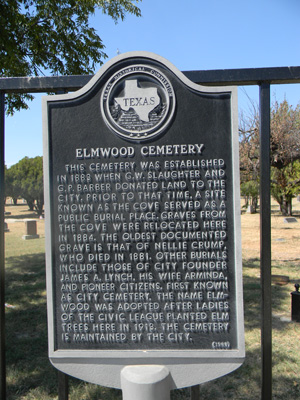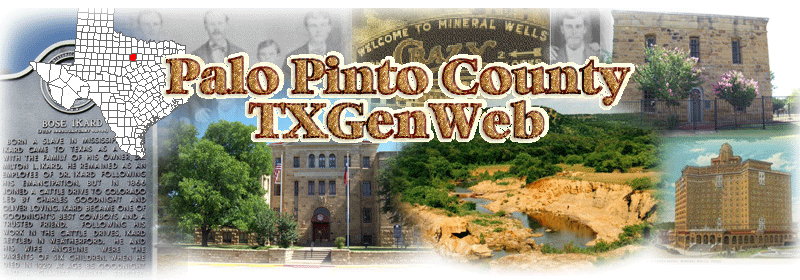|
Jonathan Hamilton Baker
Bethel Strawn, C.S.A.
The George Rice Bevers Homesite
Black Springs
Simpson Crawford
Elmwood Cemetery in Mineral Wells
Charles Goodnight
Site the Home in 1885 of Oliver Loving, 1812-1867
Morris Sheppard Dam and Possum Kingdom Lake
Jonathan Hamilton Baker
July 13, 1832 – October 18, 1918
US 180, off NE corner of Courthouse Square
Virginia native Jonathan Hamilton “Ham” Baker came to Texas in 1858 with his brother G.W. Baker and his uncle Eli Young. Stricken by malaria while a teacher in Fort Worth, he later moved to Palo Pinto County where his uncle Frank Baker was homesteading. Here he opened a school, believed to be the first regularly organized school in Palo Pinto, and soon after helped establish the town’s first Methodist church..
In 1859, Baker was chosen to lead a company of local men organized to defend the area against Indian attacks. He first served under Capt. J.R. Baylor and later participated wit Capt. Lawrence Sullivan Ross in the recovery of Cynthia Ann Parker, the white woman seized by Comanches in 1836. During the Civil War he served as the leader of the home guard.
Bethel Strawn, C.S.A.
N. City Limits of Strawn, SH 16
An 1858 settler and leading citizen of Palo Pinto County. Enlisted 1864 in Co. B, 1st Frontier District, Texas State Troops, in Maj. Wm. Quayle’s command. Saw service mainly in keeping down Indian depredations and protecting settlements that were furnishing food, salt, hides, leather, and other goods to aid the Confederate cause during the Civil War.
In 1880, when Texas & Pacific Railroad built through western Palo Pinto County, a stop was named for Bethel Strawn, who owned land at that point. By 1885, Strawn settlement had grown into a town drawing off people from old Palo Pinto.
During the 20th century oil developments, the name Strawn is used for petroleum bearing formations of rock that underlie this county and other areas. Strawn minerals include coal, once mined locally.
36 Texas counties were named for men prominent in the Confederacy during the Civil War. One county Val Verde, was named for a Civil War battle field on which Texas troops were victorious during the New Mexico-Arizona Campaign of 1861-1862.
41 Texas towns were named for men who figured in the Civil War. Strawn, however, is the one geological name commemorating a Texan in the Civil War.
The George Rice Bevers Homesite
SH 254, 2 mi E of Graford
On the Fort Worth-Fort Belknap Road, near Flat Rock Crossing of Keechi Creek. Occupied in 1854 when such travelers as Indian Agent, Robert S. Neighbors were fed or housed overnight by Bevers. The first Palo Pinto County school opened in the vicinity in 1856, on a path smoothed by oxen pulling a log. In Bevers cemetery lies a victim of 1860’s Indian raids that sent settlers to refuges as remote as the courthouse in Fort Worth.
George Rice Bevers (1825-1904), his wife, Lucinda, Jane Tacker (1825-1873), and children lived near Curetons, Goodnights, Slaughters, other noted pioneers.
Simpson Crawford
SH 254, roadside park, 3 miles East
A native of Kentucky, Simpson Crawford (1824-1908) served in the Mexican War (1846-1848) at Vera Cruz and Mexico City. Following the war he returned to Kentucky and married Elizabeth Evans. In 1852, they moved to Texas, settling first in Titus County. In 1854, they came to Palo Pinto County and built a home (3/4 miles NW) in the Keechi Valley area of Peters Colony. A successful rancher owning 3, 100 acres. Crawford also served in the Texas Rangers. His first wife died in 1858 and he married Mary Brown four years later. He is buried in Crawford Cemetery (1.5 miles North).
Morris Sheppard Dam and Possum Kingdom Lake
A project of the Brazos River Authority
Observation Point, .5 mile S of FM 2353, 15 miles SW
Built in response to disastrous Brazos River flooding, Morris Sheppard Dam and Possum Kingdom Reservoir were early attempts at water conservations and flood control in Texas. The U.S. Government funded $4,500,000 of the three- year, $8,500,000 project through the Works Progress Administration, a Depression era recovery agency. Named for U.S. Senator Morris Sheppard and completed in 1941, the dam is 2,740 feet long and 190 feet high. Nine spillway gates allow for the passage of flood waters and drift material. Power generating facilities consist of two 11,250 kilowatt units which serve much of the surrounding area.
The creation of Possum Kingdom Lake from the impounded waters of Morris Sheppard Dam sent bridges, roads, and an entire town underwater. Recovery was initially slow, but quickly picked up after World War II with the establishment of major fishing lodges, camping areas, and other recreational facilities. The growth and success of the area is a tribute to the spirit of the surrounding communities which continuje to benefit from the project’s original purposes of water conservation and supply, and hydroelectric power generation.
Site the Home in 1885 of Oliver Loving, 1812-1867
9 miles N on U.S. 281
First trail driver of Texas Cattle. Loving Valley and a county in Texas bear his name.
Charles Goodnight
FM 52, 2 miles from SH 254, W. of Graford
Here at Black Springs in the Keechi Valley in 1857, the celebrated pioneer open range cowman and trail driver Charles Goodnight (1836-1929) located his first ranch on the extreme Indian frontier of Texas. From here he took part in the 1860 Pease River fight when Cynthia Ann Parker was recaptured from Comanches. He served as scout and guide for the Texas Rangers during the Civil War and in 1866 he laid out the Goodnight-Loving Cattle Trail over which thousands of Longhorns were driven to market in New Mexico. In 1867, at Fort Sumner, New Mexico, his partner Oliver Loving died from wounds suffered in an Indian attack. Without the aid of an undertaker, Goodnight carried the body by wagon through hostile Indian territory for burial at Weatherford (24 miles SE)
Good night extended his cattle trails to Wyoming and to Colorado, where he started a ranch near Pueblo. In 1876, he established the first cattle ranch in the vast Texas Panhandle, which became internationally known, J A Ranch. Involved in the preservation of the area’s native buffalo, he also bred the first herd of cattalo by crossing buffalo with range cattle.
Goodnight’s pioneer efforts led to the development of the frontier and the Texas cattle industry.
Settled before the Civil War and named for the area’s early water source, located nearby, the Black Springs community played a significant role in the growth of Palo Pinto County. Prominent individuals associated with the town included early cattlemen and trail drivers Oliver Loving, Charles Goodnight, and J.J. “Jack” Cureton, a noted military veteran and pioneer. In 1886, the community was renamed Oran in honor of Texas Governor Oran M. Roberts. Once the county’s leading town and the site of stores, churches, a school and railroad, it declined in the 1930s and 1940s.
Elmwood Cemetery
Mineral Wells
Transcription: This cemetery was established in 1883 when G.W. Slaughter and GP Barber Donated land to the city. Prior to that time, a site known as the Cove served as a public burial place. Graves from the Cove were relocated here in 1884. The oldest documented grave is that of Nellie Crump, who died in 1881. Other burials include those of city founder, James A Lynch, his wife, Arminda, and pioneer citizens. First known as City Cemetery, the name Elmwood was adopted after Ladies of the Civic League planted Elm trees here in 1919. The cemetery is maintained by the city.
If you have any suggestions, questions about this page, or have information you would like to add, please contact Lela Evans.
© Copyright 2005-2011 by Lela Evans. All rights reserved. This site may be freely linked to but not duplicated in any fashion without my consent. Information from this site may be freely used by individuals doing private, family research.



